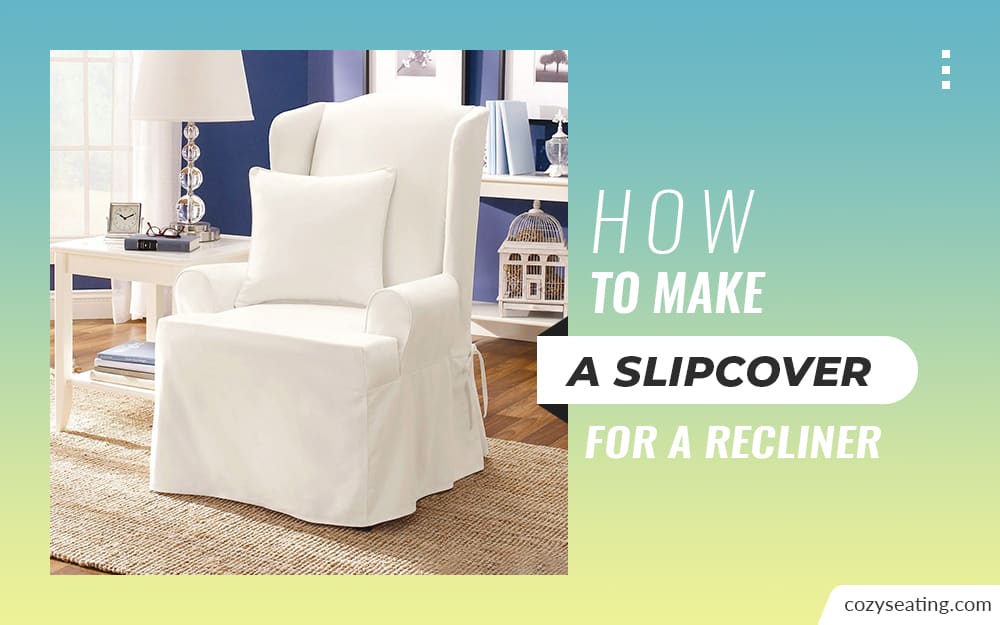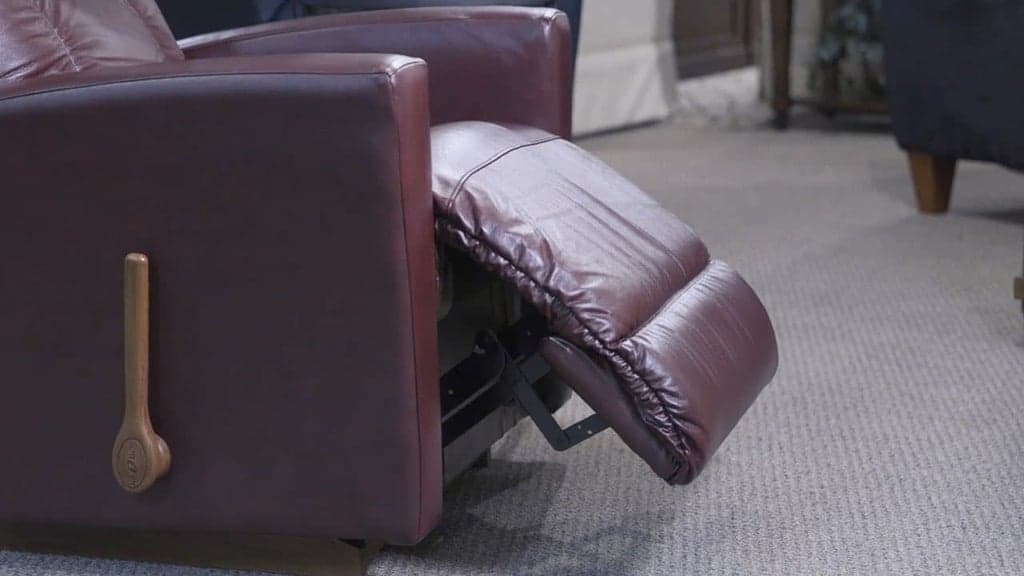
Disclosure: This site is reader-supported & contains affiliate links. We may earn a commission through products purchased using links on this page. Learn more

A slipcover is easy to use and maintain. Typically, it doesn’t require any special expertise. However, it may be challenging for you to go about covering a recliner while maintaining its tilting capabilities.
Herein, I share expert steps detailing how to make a slipcover for a recliner.
Slipcovers work on recliners as they obscure blemishes, may increase comfort, and also appear pretty. You measure a recliner slipcover by allowing allowance room on your chair’s dimensions. In addition, you make slipcovers by tucking, pinning, and sewing based on a desired design.
Table of Contents
Do Slipcovers Work on Recliners?
If you’re looking to change the color or appearance of your recliner, slipcovers are ideal. They protect your prized chair from potential wear and tear, such as spills and splotches.
Additionally, if your recliner shows signs of wear, you can transform it with affordable slipcovers into a brand-new piece. There are various styles, colors, and designs to choose from.
Also, ready-made covers fit various types of recliners, so they are well worth the investment.
How To Measure A Recliner For A Cover
Using a pencil and paper, either note down the various components of the recliner or draw its rough sketch and label the components. Now, with a measuring tape, take precise measurements of all the various components of the chair that you wish to cover.
Next, measure the back from top to bottom. Begin on inner arms and make your way to the outside and the ground. Keep a running tally of these measurements on paper, besides the labels or parts list. After you measure all components, proceed to material selection.
Learn more about recliner dimensions here.
How Do You Make Slipcovers?
Identify the chair’s four significant components: back, footrest, arms, and seat. Create a separate slipcover for each section and secure it to the chair using a hook-and-loop tape or stretchy casing.
Note How the Arms and Backrest of the Chair Affix to Your Recliner
Hook-and-loop tape secures the arms to the chair’s inside down the front length. Also, the tape stretches vertically over the exterior edge on the rear and the inner arm below the seat’s bottom.
The tape also secures the bottom edge to the recliner’s back. The arm slipcover tethers to the chair’s outside back, while the back slipcover drapes over the arms along the chair’s exterior back edge.
Stretch the Back Area of the Chair and the Bottom Edge of the Inner Back
By stretching, you can determine how its hook-and-loop tape adheres to the seat’s underside along the flanks, forming a tuck. The fabric for the footrest connects via an elastic casing that wraps around its underside.
Take note of the position of any mechanisms while inspecting the chair. To accommodate these areas, you may need to create a faced opening.
Pattern Development
Use light fabric such as broadcloth to develop pattern pieces for every slipcover section. Arrange the fabric on the section, trace it with a fabric marking pencil, and trim the design, letting 3/4-inch excess for all seams.
Take note of the layout on the pattern piece; this indicates the direction for fabric pattern placement and serves as a reference point when stitching the bits together. If you’re unsure, jot down the layout for future reference.
Sew the Pattern Together and Confirm the Fit of Every Segment
Make necessary adjustments and reconfirm for fit. Take note of the hook-and-loop tape’s proposed location on each pattern piece.
Trim the fabric based on your pattern pieces after removing the basting stitches. Assemble the pieces. Finish the edges as you like. Apply the hook-and-loop tape according to your pattern. Sew the seat’s back edge and the inside back’s bottom edge together.
Staple the hook-and-loop tape’s corresponding side to the chair. Place the wrap on your recliner and secure the cover in place with the hook-and-loop strips.
Cut a piece of fabric adequate to encase the footrest, plus 4 inches on the rear. Complete the perimeter by finishing the edges and sewing an inch elastic encasement surrounding it. Allow a 1-inch gap in the casing.
Calculate the fabric’s perimeter, cut a length of 1/2-inch elastic equal to half the perimeter, and put it into the encasement. Sew the elastic edges tight and close the casing opening. Slide your cover over the footrest and evenly distribute the gathering.
Related reading: How to cover a recliner with a sheet
How Do You Keep a Recliner Cover in Place?
Remove the slipcover and begin a new to attain snug secure fitting using these steps:
- Clean and dry your slipcover to ensure it’s wrinkle-free.
- Center it over your recliner and smooth it. Surplus cloth may make it challenging to smooth it perfectly, but try to eliminate as many bumps and wrinkles as possible.
- Tuck the excess fabric into the couch’s crevices. Begin in a single location like the arm. Continue smoothing and tucking as you go. Proceed to the opposite arm and so forth.
- Push the cloth as deeply as possible into the crevices. Deeply tucking keeps the cloth in place and prevents it from pulling up. Use tools like a spoon to achieve a snug tuck if necessary.
Adding materials like magazines into the crevices can also enhance the steadiness of the cover.
FAQs
How Do I Choose a Recliner Cover?
The simplest method for you to choose a recliner cover is by looking for the following characteristics:
- A revamp in the softness or plushness of your recliner
- Fabric that is adequately durable to withstand heavy traffic and recurring cleanings
- Gorgeous colors, designs, or textures that appear similar to or classier than your recliner.
Are 1 Piece or 4 Piece Recliner Covers Better?
More pieces mean a more straightforward cover installation. Additionally, the recliner appears more tailored by using separate pieces, as the slipcover seems custom-made.
If you choose a one-piece cover, look for one with discreet label placement. The labels eliminate the guesswork and assist you in correctly positioning the slipcover.
Simply put, 4 piece recliner covers are better than 1 piece.
How Do I Know What Slipcover Fits?
Although many recliner slipcovers are one-size-fits-all, the chair’s size can help you know what slipcover fits. Standard chair covers fit between 30 and 37-inch chair widths, while small and extra-large versions are available.
Some accommodate chairs with a width of 40 inches. If you have a large recliner, select a slipcover that contains a high percentage of spandex to allow it to stretch further.
Conclusion
While it may be challenging to pimp up your chair, I believe my how to make a slipcover for a recliner guide answers your questions. So, I hope you can now easily create a slipcover for your chair that’s stylish while not limiting your recliner’s operations.
Recommended Reading

The Ultimate Guide on How to Fix a Lazy Boy Recliner
Lazy Boy recliners are a popular brand of recliner. If you have a Lazy Boy recliner, you may have problems with it. Here's how to fix a Lazy Boy recliner.

How To Fix A Recliner Footrest: Causes And 3 Different Solutions
Is your recliner footrest faulty? Here is an easy-to-follow guide on how to fix a recliner footrest. Also included are the major causes of a malfunctioning footrest.

Recliner Vs. Gaming Chair
Welcome to our definitive guide on recliner vs. gaming chair. What differentiates the two comfy chairs? How do you pick an ideal recliner or a gaming chair?

How Much Does it Cost to Fix a Power Recliner?
Fixing a power recliner can be a huge investment, but it doesn't have to be. So, how much does it cost to fix a power recliner? Let’s find out if it’s worth it.
